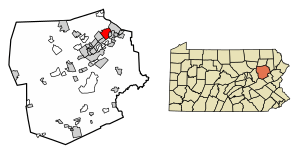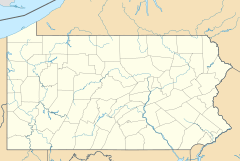Exeter, Pennsylvania facts for kids
Quick facts for kids
Exeter, Pennsylvania
|
|
|---|---|

House on Slocum Avenue
|
|

Location of Exeter in Luzerne County, Pennsylvania.
|
|
| Country | United States |
| State | Pennsylvania |
| County | Luzerne |
| Region | Greater Pittston |
| Incorporated | 1884 |
| Government | |
| • Type | Borough Council |
| Area | |
| • Total | 4.92 sq mi (12.75 km2) |
| • Land | 4.62 sq mi (11.96 km2) |
| • Water | 0.31 sq mi (0.80 km2) |
| Population
(2020)
|
|
| • Total | 5,514 |
| • Density | 1,194.54/sq mi (461.19/km2) |
| Time zone | UTC-5 (Eastern (EST)) |
| • Summer (DST) | UTC-4 (EDT) |
| ZIP Code |
18643
|
| Area code(s) | 570 |
| FIPS code | 42-24392 |
Exeter is a small town, called a borough, in Luzerne County, Pennsylvania, USA. It's located near the cities of Wilkes-Barre and Scranton. Exeter sits on the western bank of the Susquehanna River. The borough covers about 12.9 square kilometers (5.0 square miles). In 2020, about 5,513 people lived in Exeter.
Contents
Exeter's Past: A Look at History
The name Exeter comes from an old city in England, also called Exeter. Many other places in the world share this name.
Early Settlers and Conflicts
In 1769, people from Connecticut started building homes in the Wyoming Valley of Pennsylvania. They soon had disagreements with settlers from Pennsylvania. These fights were known as the Pennamite–Yankee Wars.
Revolutionary War Events
During the Revolutionary War in July 1778, a group called Butler's Rangers and their Iroquois allies attacked the valley. Two forts, Fort Wintermoot (in what is now Exeter) and Fort Jenkins, quickly gave up and were later burned. On July 3, 1778, a major battle happened. It was called the Battle of Wyoming, or the Wyoming Massacre. About 300 American soldiers died in this battle, which took place in present-day Exeter and Wyoming.
Growth and Industry
Exeter was first a rich farming area. It was once the homeland of the Susquehannock people. In the 1800s and 1900s, people in the area focused on cutting down trees for lumber and mining coal.
By the 1830s, the region began to grow quickly. Coal was shipped using the Pennsylvania Canal. By the 1840s, coal went down the Lehigh Canal to cities like Allentown, Philadelphia, and New York City. This was possible because of important engineering projects like the upper Lehigh Canal and early railroads.
After big floods damaged the upper Lehigh Canal in the 1860s, new rail lines were built. These lines helped keep the coal mines connected to the big cities. This allowed coal to continue being sent to the East Coast.
Becoming a Borough and Later Challenges
Exeter officially became a borough in 1884. By 1900, its population had grown to 1,948 people.
In 1959, the town faced a big disaster called the Knox Mine Disaster. The river broke through and flooded the local coal mines. This event largely stopped coal mining in Exeter and the surrounding areas. Even though the mining industry ended, the population still grew. By 2010, 5,652 people lived there, showing that the old farmlands became popular for building new homes.
Exeter's Location: Geography Facts
Exeter is located along the western bank of the Susquehanna River. U.S. Route 11 runs through the southern part of the town. This highway connects Exeter to the boroughs of West Pittston and Wyoming. Most of Exeter's streets are built around this highway.
PA 92 goes through the eastern part of the borough. It connects West Pittston and Exeter Township. The Fox Hill Country Club is in central Exeter. The borough surrounds West Pittston on three sides: north, south, and west.
Two islands, Scovell Island and Wintermoot Island, are located within Exeter's borders on the Susquehanna River. The northern part of the borough mostly consists of hills and forests.
According to the United States Census Bureau, Exeter covers about 12.9 square kilometers (5.0 square miles). Of this, 12.1 square kilometers (4.7 square miles) is land, and 0.8 square kilometers (0.3 square miles) is water. The water makes up about 6.52% of the total area. Exeter's ZIP code is 18643.
Who Lives in Exeter: Demographics
| Historical population | |||
|---|---|---|---|
| Census | Pop. | %± | |
| 1890 | 790 | — | |
| 1900 | 1,948 | 146.6% | |
| 1910 | 3,537 | 81.6% | |
| 1920 | 4,176 | 18.1% | |
| 1930 | 5,724 | 37.1% | |
| 1940 | 5,802 | 1.4% | |
| 1950 | 5,130 | −11.6% | |
| 1960 | 4,747 | −7.5% | |
| 1970 | 4,670 | −1.6% | |
| 1980 | 5,493 | 17.6% | |
| 1990 | 5,691 | 3.6% | |
| 2000 | 5,955 | 4.6% | |
| 2010 | 5,652 | −5.1% | |
| 2020 | 5,513 | −2.5% | |
| 2021 (est.) | 5,510 | −2.5% | |
| Sources: | |||
In 2000, there were 5,955 people living in Exeter. These people lived in 2,482 households, and 1,640 of these were families. The population density was about 1,278 people per square mile.
Most of the people in Exeter were White (98.69%). A small number were African American (0.49%), Native American (0.13%), or Asian (0.13%). About 0.57% of the population was Hispanic or Latino.
About 26% of households had children under 18 living with them. Nearly half (48.8%) were married couples living together. The average household had 2.35 people, and the average family had 2.92 people.
The population was spread out by age. About 21% were under 18, and 20.9% were 65 or older. The average age was 41 years old.
Learning in Exeter: Education
Exeter is part of the Wyoming Area School District. This district serves the public schools in the area. There is also a private school in the borough, Wyoming Area Catholic School, which is a parochial school (a school run by a church).
Famous Faces: Notable People from Exeter
- Joe Amato: A famous drag racer who won the NHRA Top Fuel championship five times.
- Anthony Petrosky: A well-known poet.
- Ann A. Bernatitus: A nurse in the United States Navy during World War II. She was the first American woman to receive the Legion of Merit award.
See also
 In Spanish: Exeter (Pensilvania) para niños
In Spanish: Exeter (Pensilvania) para niños



